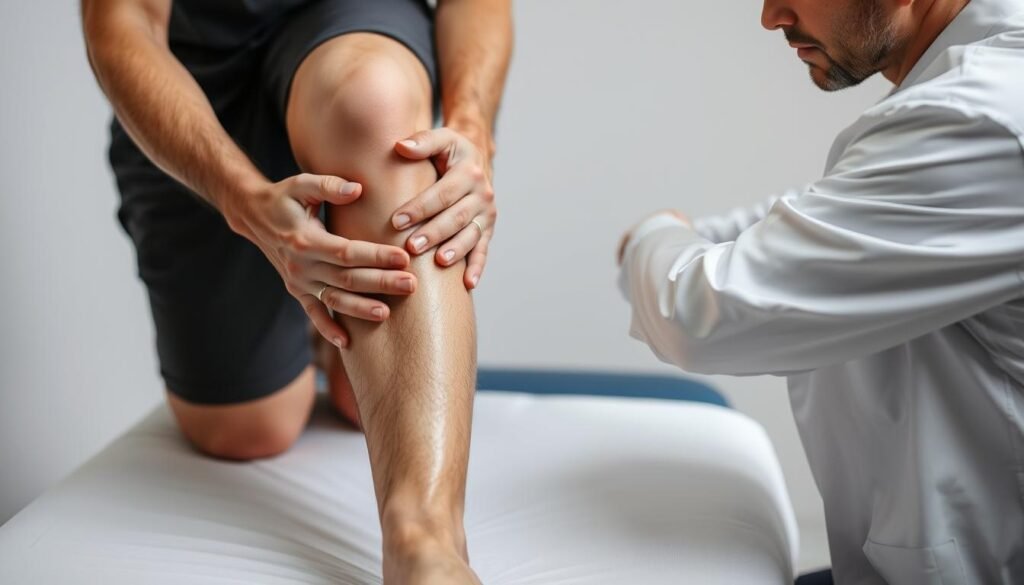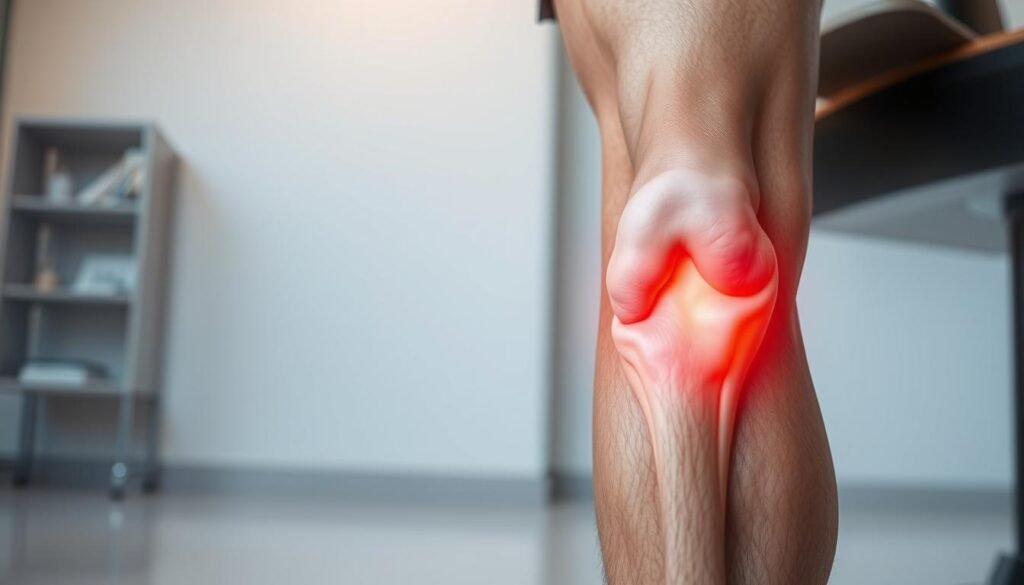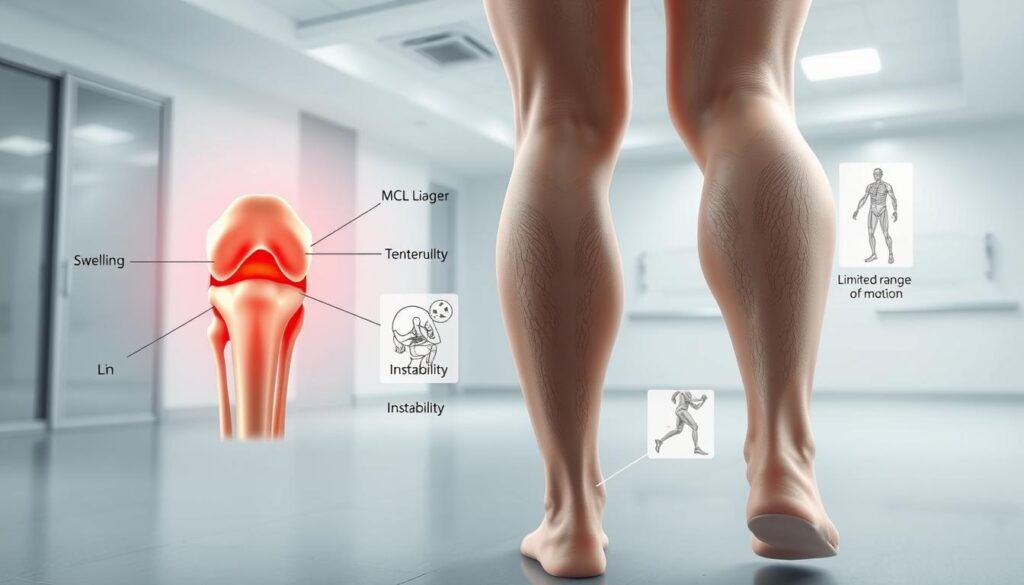
Have you ever wondered if a sharp knee pain could mean a torn medial collateral ligament (MCL)? The MCL is a crucial ligament that provides stability to your knee, and its injury can significantly impact your mobility. Understanding the signs of an MCL tear is essential for proper diagnosis and treatment.
The MCL, or medial collateral ligament, plays a vital role in maintaining knee stability. A tear in this ligament can occur due to direct trauma to the knee or sudden twisting motions. Early indicators often include pain, swelling, and difficulty bearing weight on the affected leg.

Diagnosing an MCL tear involves a combination of physical examinations and imaging tests. Medical professionals often classify MCL injuries into three grades, ranging from mild sprains to complete tears. This classification helps determine the appropriate treatment plan, which may include rest, bracing, or physical therapy.
In this article, we will guide you through the anatomy of the MCL, common symptoms of a tear, and the various treatment options available. Whether you’re seeking to understand the injury better or looking for recovery strategies, this comprehensive guide will provide you with the insights you need.
Key Takeaways
- The MCL is essential for knee stability and can be injured through direct trauma or twisting motions.
- Symptoms of an MCL tear include pain, swelling, and difficulty bearing weight.
- Diagnosis typically involves physical exams and imaging tests.
- MCL tears are classified into three grades, influencing treatment plans.
- Treatment often includes rest, bracing, and physical therapy, with surgery reserved for severe cases.
Understanding the Medial Collateral Ligament (MCL)
The medial collateral ligament, or MCL, is one of the key ligaments that help stabilize the knee joint. Located on the inner side of the knee, it plays a crucial role in connecting the femur (thigh bone) to the tibia (shin bone). This ligament is essential for maintaining proper knee alignment and preventing excessive side-to-side movement.
Anatomy and Function of the MCL
The MCL is a strong, fibrous band that runs from the inner aspect of the femur to the inner aspect of the tibia. Its primary function is to provide stability to the knee, especially during activities that involve twisting or bending. Without the MCL, the knee would be more susceptible to instability and injury.
The Role of Collateral Ligaments in Knee Stability
Collateral ligaments, including the MCL, work together to prevent excessive movement in the knee joint. While the MCL focuses on stabilizing the inner side of the knee, the lateral collateral ligament (LCL) does the same for the outer side. Together, they ensure that the knee remains stable during various movements, reducing the risk of tears or injuries.
Common Symptoms of an MCL Tear
Identifying the symptoms of a torn MCL is crucial for early diagnosis and effective treatment. The medial collateral ligament plays a vital role in knee stability, and its injury can lead to noticeable physical changes and discomfort.
Identifying Pain, Swelling, and Instability
The most common symptoms of an MCL tear include pain on the inner side of the knee, noticeable swelling, and a feeling of instability. Pain is usually sharp and localized, worsening with movement. Swelling may develop within hours of the injury and can be severe, depending on the tear’s severity. Instability, or a feeling that the knee might give way, is another hallmark symptom that can interfere with weight-bearing activities.
The Telltale Popping Sensation
Many patients report hearing or feeling a popping sensation at the moment of injury. This sound often indicates the ligament’s fibers snapping. In some cases, this sensation can be accompanied by a sudden shift in the knee’s position, which may cause immediate pain and swelling. It’s important to monitor these symptoms closely, as they can develop over a short period—sometimes as little as a week—and may even affect nearby bones.
| Symptom | Onset | Effect on Nearby Bones |
|---|---|---|
| Pain | Immediate or delayed | May radiate to surrounding areas |
| Swelling | Within hours | Can cause pressure on adjacent structures |
| Instability | During movement | Increases risk of further injury |
| Popping Sensation | At injury time | Indicates ligament damage |
While some symptoms may improve with conservative management, it’s essential to seek medical consultation to avoid complications. Early diagnosis ensures proper treatment, whether through non-surgical methods or, in severe cases, surgery. Recognizing these signs early can significantly impact recovery time and overall knee health.
how do i know if i tore my mcl
Recognizing the signs of an MCL tear is the first step toward effective treatment. The medial collateral ligament plays a crucial role in knee joint stability, and its injury can significantly impact mobility. Understanding the timeline of symptoms and the specific examinations used to assess joint stability is essential for an accurate diagnosis.
Recognizing the Signs Specific to MCL Injury
The onset of symptoms can vary, but most individuals experience pain and swelling within hours of the injury. Over time, these symptoms may progress, affecting the knee joint’s stability. Clinicians often perform resistance tests and pain mapping to evaluate the severity of the case.
In many cases, immediate therapy is recommended to prevent further damage and promote healing. Early recognition of these signs can lead to a more prompt and effective treatment approach, ensuring better outcomes for the knee joint.
| Symptom | Onset | Effect on Nearby Bones |
|---|---|---|
| Pain | Immediate or delayed | May radiate to surrounding areas |
| Swelling | Within hours | Can cause pressure on adjacent structures |
| Instability | During movement | Increases risk of further injury |
| Popping Sensation | At injury time | Indicates ligament damage |

Grading the Severity of MCL Injuries
Understanding the severity of an MCL injury is crucial for effective treatment. Medical professionals classify MCL tears into three grades, each with distinct symptoms and treatment approaches.
Grade 1: Mild Torn Ligament
A Grade 1 injury involves a mild tear of the MCL. Symptoms include minor pain and swelling, with little to no instability. Athletes can often continue their activities with minimal discomfort. Recovery typically occurs within a few weeks with conservative treatment.
Grade 2 and 3: Moderate to Severe Tears
Grade 2 injuries involve a partial tear, leading to noticeable pain, swelling, and moderate instability. Grade 3 is a complete tear, causing severe pain, significant swelling, and instability. These grades often require extended rehabilitation and, in severe cases, surgical intervention.
| Grade | Symptoms | Effect on Tibia |
|---|---|---|
| 1 | Mild pain, slight swelling | Minimal impact |
| 2 | Noticeable pain, moderate swelling | Some stress |
| 3 | Severe pain, significant swelling | High risk of further injury |
Proper diagnosis using imaging techniques like MRI is essential for determining the grade and guiding treatment. Early diagnosis ensures a tailored approach, improving recovery outcomes for athletes and non-athletes alike.
Non-Surgical Treatment Options
When dealing with an MCL tear, non-surgical treatments are often the first line of defense, especially for lower-grade injuries. These methods focus on reducing pain, swelling, and restoring knee function without invasive procedures.
RICE Method and Use of Medication
The RICE method—Rest, Ice, Compression, and Elevation—is a widely recommended approach for managing MCL tears. Resting the knee is crucial to avoid further strain, while ice helps reduce swelling. Compression, using an elastic bandage, and elevation above heart level can also alleviate discomfort. Over-the-counter medications like ibuprofen or naproxen (NSAIDs) are commonly prescribed to manage pain and inflammation during the initial stages.
Role of Physical Therapy and Knee Braces
Physical therapy plays a vital role in the recovery process. It helps strengthen the muscles around the knee, improving stability and reducing strain on the inner side of the knee. Knee braces can provide additional support, especially during physical activity, allowing the MCL to heal without further injury. Therapy programs are tailored to the injury grade, ensuring a gradual return to normal activities, particularly for those involved in sports.
Timely and appropriate non-surgical care can often restore knee function without the need for surgery. By combining the RICE method, medication, physical therapy, and knee braces, many individuals can achieve a full recovery, particularly in lower-grade injuries. This approach is especially beneficial for athletes looking to return to their sport without prolonged downtime.
When Is Surgery Required for MCL Tears?
Surgical intervention is typically reserved for severe cases of MCL tears. While many injuries heal with non-surgical treatments, certain conditions necessitate operative care to restore knee stability and function.
Criteria for Considering Surgical Intervention
Surgery is often recommended in cases where the MCL tear is accompanied by other ligament injuries, such as ACL tears, or when there’s significant instability that doesn’t improve with conservative treatments. Persistent swelling and instability, especially when the inside knee is severely affected, are key indicators for surgical intervention.
| Criteria | Description |
|---|---|
| Combined Injuries | Presence of other ligament tears (e.g., ACL) |
| Persistent Instability | Knee remains unstable despite non-surgical treatments |
| Severe Swelling | Significant swelling that doesn’t reduce with therapy |
Surgical Methods and Post-Operative Care
Surgical methods include arthroscopy for minor repairs and open surgery for more severe cases. Post-operative care involves dedicated physical therapy to accelerate recovery and the use of braces for added support. With proper recovery strategies, outcomes are generally positive, especially for active individuals.
Diagnostic Tests and Imaging Techniques
When evaluating a knee injury, medical professionals rely on various diagnostic tests to accurately assess the extent of the damage. These tests are crucial for determining the severity of an MCL tear and guiding the appropriate treatment plan.
X-rays, MRI, and Ultrasounds Explained
X-rays are often the first step in diagnosing a knee injury. They help rule out fractures and provide a clear view of the bone structure. For MCL tears, stress X-rays are particularly useful. These images are taken while the knee is under stress, allowing doctors to measure the range of motion and assess ligament laxity.
Magnetic Resonance Imaging (MRI) offers a detailed look at soft tissues, including ligaments and tendons. It is especially effective in identifying tears on the inner side of the knee. An MRI can reveal subtle injuries that might not be visible on an X-ray, making it a valuable tool for diagnosing MCL tears.
Ultrasounds are another imaging option, providing real-time visuals of the knee. They are less commonly used for MCL tears but can be helpful in certain cases. Combining these imaging techniques gives a comprehensive understanding of the injury.
Measuring Stability and Range of Motion
Stress tests are essential for evaluating knee stability. These tests involve applying gentle pressure to the inner side of the knee to assess ligament integrity. By measuring the range of motion under stress, doctors can determine if the MCL is torn and how severely.
In some cases, applying ice during the initial evaluation can help reduce pain and swelling, making the diagnostic process more accurate. Early and precise diagnosis is critical for effective treatment, whether through conservative methods or surgery.
These diagnostic tests provide critical insights into the nature and severity of the ligament injury, ensuring a tailored approach to recovery and rehabilitation.
Rehabilitation, Recovery, and Preventing Future Injuries
Recovering from an MCL tear requires a structured approach to ensure proper healing and prevent future injuries. Whether you’re an athlete or an active individual, a well-planned rehabilitation program is key to restoring knee function and strength.
Rehabilitation Exercises and Timeline
The rehabilitation process typically spans several weeks, with a focus on restoring strength, flexibility, and stability. Early stages often involve the RICE method (Rest, Ice, Compression, and Elevation) to reduce swelling and pain. As the injury heals, gentle exercises like straight-leg raises and hamstring stretches are introduced to improve mobility.
Physical therapy plays a crucial role in the intermediate phase, incorporating exercises that strengthen the muscles around the knee. Activities like cycling and swimming are excellent low-impact options to maintain fitness without putting excessive strain on the knee. Most patients can return to light activities within 4-6 weeks, but full recovery may take up to 3 months.
Strategies for Injury Prevention and Long-Term Care
To prevent re-injury, it’s essential to adopt long-term care strategies. This includes proper warm-ups before any physical activity, especially high-impact sports like soccer. Using supportive braces during intense activities can provide additional stability to the knee.
Avoiding overexertion and ensuring proper technique during exercises or sports is equally important. Strengthening the surrounding muscles through targeted exercises can significantly reduce the risk of future injuries. By adopting these preventive measures, individuals can maintain knee health and enjoy their favorite activities without setbacks.
Conclusion
Understanding and addressing an MCL injury requires a comprehensive approach that combines awareness, timely medical consultation, and proper rehabilitation. Recognizing the symptoms—such as pain, swelling, and instability—allows for early diagnosis, which is critical for effective treatment. Whether opting for non-surgical methods like the RICE technique or considering surgery for severe cases, each approach has its benefits and recovery timelines.
Monitoring motion and range of motion is essential during rehabilitation. These indicators help track progress and ensure the knee is healing properly. Following rest guidelines and incorporating physical therapy can significantly improve outcomes. If you suspect an MCL injury or a grade MCL tear, consulting with a medical professional is the first step toward recovery.
Early diagnosis and targeted treatment empower individuals to safely return to their daily activities and sports. By prioritizing proper care and rehabilitation, you can restore knee function and reduce the risk of future injuries. Remember, taking proactive steps now leads to a stronger, healthier knee in the future.
FAQ
What are the common symptoms of an MCL tear?
Common symptoms include pain on the inner side of the knee, swelling, and instability. You might also hear a popping sound at the time of injury.
How is an MCL tear diagnosed?
Diagnoses often involve a physical exam and imaging tests like X-rays, MRI, or ultrasound to assess the ligament and surrounding structures.
What treatment options are available for an MCL tear?
Treatment may include the RICE method (Rest, Ice, Compression, Elevation), physical therapy, or a knee brace. In severe cases, surgery might be necessary.
How long does it take to recover from an MCL injury?
Recovery time varies. Grade 1 tears may heal in a few weeks, while Grade 3 tears could take several months and may require physical therapy to restore strength and mobility.
Can I prevent an MCL injury?
Yes, strengthening exercises, proper warm-ups, and using protective gear can help reduce the risk of injury, especially for athletes in contact sports like soccer.
When should I see a doctor for a knee injury?
Seek medical attention if you experience severe pain, significant swelling, or difficulty moving your knee. A doctor can determine if it’s an MCL tear or another issue.
How does physical therapy help in recovery?
Physical therapy helps restore range of motion, strengthens muscles around the knee, and improves stability, reducing the risk of future injuries.
What are the grades of MCL tears?
Grade 1 is a mild tear with some stretching. Grade 2 is a moderate tear with partial ligament damage. Grade 3 is a complete tear, causing significant instability.
Can MCL tears heal without surgery?
Most MCL tears heal with non-surgical treatments like bracing and physical therapy. Surgery is typically reserved for severe or complex tears.
How can I manage pain from an MCL tear?
Use ice to reduce swelling, take pain relievers as directed, and rest the knee. A knee brace can provide additional support during recovery.
